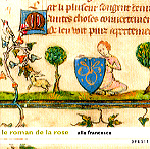This imaginative program is a compilation of motets and chansons–both mono- and polyphonic–by some of the greatest early masters, interspersed with short readings from the famous 13th-century French romance poem Roman de la Rose. The subject, of course, is courtly love, and the musical selections, especially those by Machaut (motet, ballades, and virelai) and Binchois are among the finest examples of these styles. The three-voice rondeau “Tant con je vivrai”, by Adam de la Halle, is a delightful entertainment and the concluding ballade by Dufay, the inimitable “Se la face ay pale”, is clearly and carefully sung even if the ensemble technique is a bit rough around the edges. The instrumental contributions–everything from vielle and rebec to harp, cornemuse, and all manner of flutes–add the vivid color and flavor we expect from music of this period.
The problem is the close-up, under-a-microscope sound that doesn’t allow sufficient space for the voices to blend and resonate as they naturally would in a proper listening situation. The overall quality is rough and edgy, an effect that may enhance the instrumental timbres but gives an unpleasant cast to some of the voices. The other problem–and this is a personal thing–is the narration. Although I understand the rationale for including the poetic readings–after all, the themes from Roman de la Rose are what this musical program is about–the insertion of spoken texts, especially in old French, is more of a distraction than an enhancement of the musical experience. After all, these texts have nothing directly to do with the musical settings, which come from other sources, and therefore, for purposes of a recorded program without benefit of visual interaction, it’s usually better to just let the music speak for itself–and for all concerned, especially when it’s this good.
































